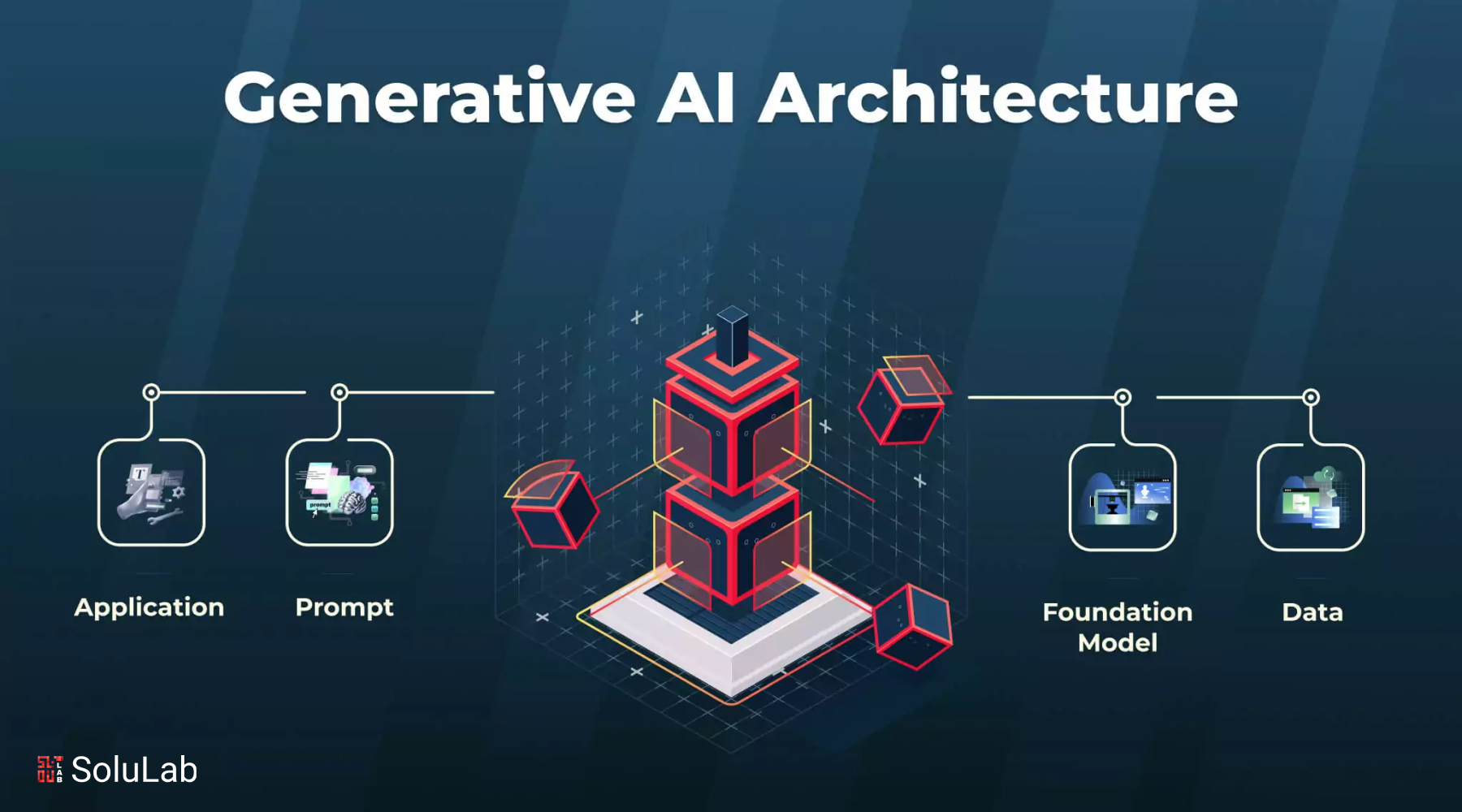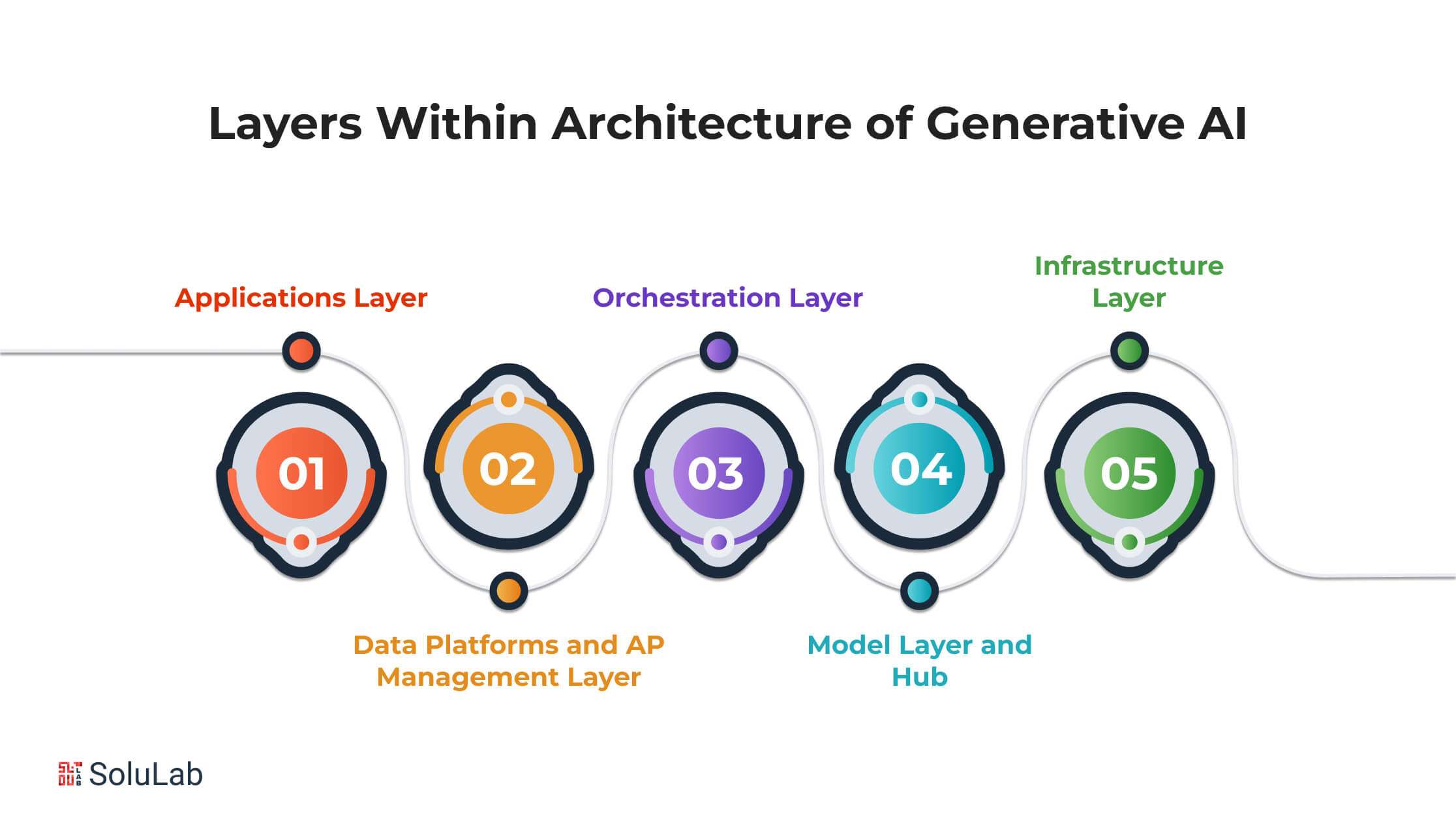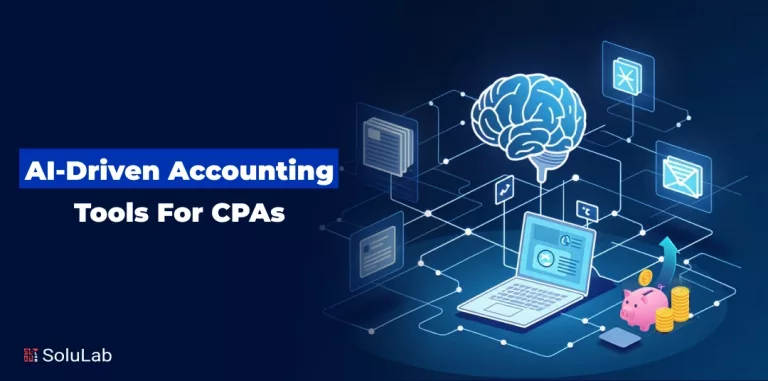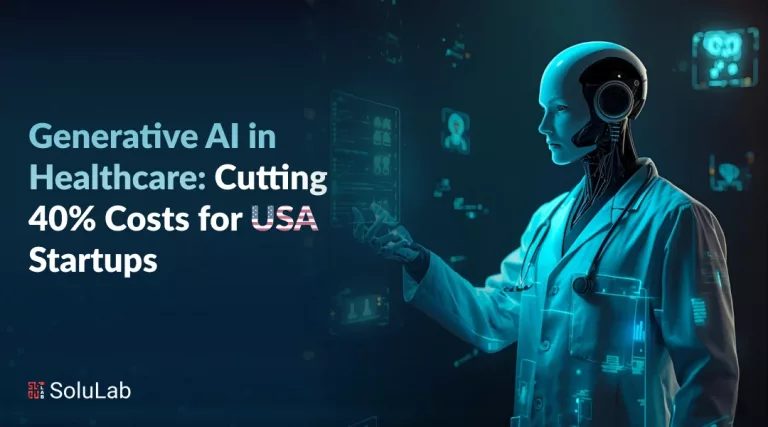
Generative artificial intelligence adoption rates are on the rise as it rapidly revolutionizes sectors. By use of a generative AI architecture diagram, one may visually depict system components and their interactions, therefore enabling improved planning and communication among stakeholders.
McKinsey claims that 71% of companies used generative artificial intelligence in at least one commercial operation in early 2025. Reflecting its increasing relevance across several industries, the worldwide generative AI market is expected to reach $66.89 billion in 2025.
Establishing an effective generative AI architecture calls for an organized approach, including data management, model selection, and system integration with current ones. A well-designed architecture ensures scalability, efficiency, and corresponds to business objectives.
This blog will guide you through the essential components of a robust generative AI architecture, including data pipelines, model frameworks, and deployment strategies. Understanding these components will help businesses to use dependable, well-organized, goal-oriented generative artificial intelligence systems.
The Foundation of Generative AI Platform Architecture
It is necessary to take a behind-the-scenes look into architecture generative AI and dissect the four pillars that support it.
1. Data Processing Layer
The raw data—text, photos, and audio—must be converted into a language the model can comprehend before the magic of creation can happen. This calls for a careful balancing act of normalization, change, and cleanliness. Audio waveforms are chopped and encoded, text is cleaned up of mistakes and inconsistencies, and photos are scaled and altered. Consider it like priming the canvas for the artist, guaranteeing the best supplies for the final masterpiece.
2. Generative Model Layer
The real alchemy takes place here. The algorithms that discover hidden patterns and correlations in the data are the engine of the generative AI model architecture, and they are tucked away within this layer. These models are the builders of the invisible, transforming the raw material into new shapes through adversarial dances such as those performed by Generative Adversarial Networks (GANs) and Variational Autoencoders (VAEs).
3. Improvement and Feedback Layer
Both generative AI models and artists are fallible. This layer uses a continuous feedback loop to guarantee ongoing learning and development. The model is trained using human judgment, well-crafted measurements, and even automated assessments, which help to optimize its methods and push its limits. Consider it as the astute critic, assisting the model in honing its skills and improving its works.
4. Integration and Deployment Layer
The model transitions from the lab to the actual world after training. Its implementation into applications spanning the gamut of human experience is orchestrated by this layer. The possibilities are endless, ranging from creating unique music and inventive materials to powering tools for creating images and personalized writing aids. The only limit is the human creativity.
Layers Within Architecture of Generative AI

The architecture of a generative AI system often has many layers, each responsible for a certain set of functions. A traditional generative AI architecture typically comprises the following fundamental layers, however, variations may occur based on specific use cases:
-
Application Layer
This layer facilitates seamless human-AI interaction. It encompasses both open-source tools and commercial, comprehensive programs. Open-source configurations provide flexibility, but private models are developed by domain specialists for particular applications, crucial for any proficient Generative AI architect creating customized solutions.
-
Data and API Management Layer
High-quality data is fundamental to the efficacy of Generative AI. Approximately 80% of the work is dedicated to vectorization, data purification, and structure. A strategy for managing unstructured data is essential for its integration into the overarching architecture of generative AI. In industries like customer support and communication, integrating this data strategy with a call center solution ensures smarter automation, better query resolution, and more personalized customer experiences.
-
Orchestration Layer (LLMOps and Prompt Engineering)
LLMOps facilitates model selection, fine-tuning, deployment, and monitoring. This layer encompasses tools for experimentation, governance, and observability, which are crucial for adjusting foundation models to corporate requirements, ranging from rapid quick engineering to comprehensive fine-tuning.
-
Model Layer and Hubs
Central to the discussion are large language models (LLMs) and machine learning (ML) foundation models, which are trained on extensive datasets and stored in model repositories. These hubs provide convenient access to pre-trained and fine-tuned models, assisting teams in optimizing development utilizing robust base models.
-
Infrastructure Layer
This layer encompasses cloud environments and specialized hardware, like as GPUs and TPUs, for training and inference. Numerous industries depend on cloud platforms for scalability, with prominent companies such as NVIDIA and Google driving the computational capabilities of Generative AI systems. NVIDIA’s H100 has emerged as the industry standard, though the h100 cost often influences whether organizations opt for on-premise deployments or cloud-based solutions.
Integrating Generative AI with Enterprise Applications
As generative AI grows, organizations are investigating its incorporation into essential business operations to improve productivity, creativity, and automation. A well-structured GenAI architecture facilitates the smooth incorporation of robust models into current systems, aligned with organizational objectives and processes. Below are many of the most significant areas for integration:
- Code Generation: Generative AI models can enhance software development by autonomously producing code snippets, recommending improvements, or even constructing full functions based on natural language inputs. Integrating these features into IDEs or internal development tools enables enterprises to accelerate delivery cycles while ensuring uniformity across projects.
- Enterprise Content Management (ECM): Integrating generative AI application architecture into ECM systems facilitates automated document summarizing, intelligent content labeling, and metadata production. This improves document searchability, compliance, and content customization across departments.
- Marketing and Customer Experience Applications: Generative AI tools can provide customized marketing material, compose campaign text, and facilitate conversational agents. Utilizing a powerful generative AI model architecture, these solutions analyze user data to provide customized experiences, hence assisting companies in enhancing engagement and loyalty on a large scale.
- Product Design and Engineering: In product development, GenAI architecture is employed to create CAD models, simulate design variants, and enhance engineering workflows. AI-facilitated ideation expedites innovation cycles and enables teams to explore a greater number of options with fewer resources.
Aligning generative AI application architecture with enterprise systems enables firms to build scalable, intelligent solutions that adapt to their operational requirements, therefore integrating generative AI as a fundamental component of corporate infrastructure.
Step-by-Step Process of How to Build an Effective Generative AI Architecture
Creating a resilient and scalable generative AI architecture necessitates a deliberate, multi-tiered methodology that corresponds with your organizational objectives, data infrastructure, and the intricacy of use cases.
Here is a systematic procedure for constructing an efficient GenAI architecture:
1. Establishing Business Objectives & Use Cases: The process begins by identifying specific business challenges or opportunities where generative AI can bring value. Whether it’s automating repetitive content, personalizing customer journeys, or forecasting trends, the use case helps shape the direction of the architecture.
2. Organizing the Data Infrastructure: Since AI systems rely heavily on data, we evaluate the existing data sources and prepare them accordingly. This involves cleaning, labeling, and sometimes transforming unstructured data, along with deciding on whether to use a data warehouse or data lake based on volume and variety.
3. Selecting the Model & Framework: Choosing the right model depends on the domain and performance needs. We compare open-source models (like LLaMA or Mistral), commercial APIs (like GPT or Claude), or build custom solutions, factoring in scalability, cost, and governance preferences.
4. Designing the Layered Architecture: With model and data foundations in place, we design a multi-layered system. This typically includes an application layer (for end-user interaction), orchestration logic (to manage prompts and workflows), a model layer, data pipelines, and the underlying infrastructure—whether on cloud or on-prem.
5. Refining with Prompt Engineering & Fine-Tuning: To enhance performance, we experiment with prompt strategies and, when needed, fine-tune models using methods like RLHF or LoRA. This allows the system to respond more accurately to domain-specific tasks and business logic.
6. Integrating with Internal Systems: For practical application, the GenAI solution is connected to internal platforms like CRM, CMS, or product databases. This is done using APIs and SDKs, ensuring that the AI system can work within existing business workflows securely and reliably.
7. Implementing Monitoring, Governance & Security: As the system becomes operational, we put monitoring tools in place to track model output, latency, and quality. At the same time, we define governance policies—like access control, privacy safeguards, and fairness checks—to maintain compliance and trust.
8. Continuous Testing, Feedback & Scaling: The rollout is gradual, starting with limited use cases. We collect real-world feedback, tweak the prompts or model behavior, and iterate. Once stable, the solution is scaled across teams or departments based on proven impact.
Applications of Generative AI Architecture Across Industries
The use of generative AI architecture is no longer exclusive to technology companies; it has transformed operations across several sectors. A generative AI course explores how generative AI is facilitating new avenues for development and innovation through the optimization of workflows and the personalization of user experiences. The following are essential areas utilizing generative AI use cases to get quantifiable results:
1. Generative AI in Healthcare
Generative AI is utilized in healthcare for medical imaging analysis, medication development, and clinical reporting. It facilitates the generation of synthetic patient data for research, the composition of discharge summaries, and helps radiologists with advanced diagnostic tools, enhancing the speed and precision of care delivery.
2. Generative AI in Banking and Finance
Financial institutions employ generative AI for risk modeling, fraud detection, automated report production, and customer service enhancement. AI-powered chatbots and document automation technologies enhance operational efficiency while guaranteeing compliance and customization in customer interactions.
3. Generative AI in E-Commerce
E-commerce platforms employ generative AI to provide dynamic product descriptions, customer support replies, and tailored shopping experiences. It facilitates the automation of inventory changes, improves visual merchandising, and generates marketing images customized to consumer behavior.
4. Generative AI in Retail Sector
Retailers are utilizing generative AI for hyper-personalized advertising, chatbot help, and store layout simulations. By developing customized promotions and utilizing predictive modeling for supply chain management, it improves productivity and consumer happiness.
5. Generative AI in Manufacturing
In manufacturing, generative AI facilitates product design, quality assurance, and predictive maintenance. It assists engineers in simulating variants, optimizing designs, and minimizing manufacturing costs by detecting inefficiencies during the initial design phases.
Future Trends in Enterprise-Generative AI Architecture
As generative AI becomes deeply embedded in enterprise ecosystems, future trends point toward more adaptive, secure, and domain-specific architectures. Companies are moving beyond experimentation to building robust systems that scale across departments and use cases. Evolving gen AI platform architecture will focus on performance, governance, and cross-functional integrations, while modular generative AI architecture examples will guide faster enterprise adoption.
Key Trends to Watch in 2025:
- Composable and Modular AI Systems
Enterprises will shift to componentized architectures, where different parts of the generative AI stack—like model selection, data ingestion, prompt handling, and output generation—can be mixed, matched, and updated independently. This makes it easier to scale across different teams and use cases. - Multi-Cloud and Hybrid Deployments
As data privacy and infrastructure preferences vary across regions and industries, future gen AI platform architecture will support flexible deployment options across public clouds (AWS, Azure, GCP) and on-premise environments, allowing organizations to maintain control over where and how their models operate. - Built-in Governance, Compliance, and Ethics
AI transparency and responsible use are no longer optional. Enterprises will implement governance frameworks directly into their architecture, including access controls, audit logs, data lineage, explainability tools, and bias detection to meet regulatory and internal standards. - Industry-Specific AI Stacks
We’ll see the rise of verticalized generative AI architecture examples tailored for specific industries—healthcare, banking, manufacturing, and retail. These will include domain-trained models, specialized APIs, and compliance frameworks that align with industry regulations and data sensitivity. - No-Code/Low-Code AI Development Tools
To make AI development accessible across non-technical teams, low-code tools will become a key layer in enterprise AI stacks. These platforms will empower marketing, operations, and product teams to build and deploy GenAI-powered solutions without writing code. - Real-Time AI Pipelines for Fast Output Generation
With increasing demands for instant content generation, conversational AI, and automated decisions, GenAI systems will evolve to support real-time streaming architectures. These pipelines will reduce latency and deliver dynamic, context-aware outputs on the fly.
Final Words
As generative AI continues to evolve, building a well-structured and scalable architecture is becoming essential for enterprises aiming to stay ahead. From streamlining operations to driving intelligent automation, a thoughtfully designed generative AI system can unlock new efficiencies across departments and industries.
At SoluLab, we specialize in crafting end-to-end solutions as a leading Generative AI development company. Our recent work with AmanBank, one of Libya’s largest private banks with over 750,000 customers and a 35% market share, demonstrates the real-world impact of AI-powered transformation. We developed a Generative AI-powered mobile banking solution that enhanced customer experience, automated responses, and enabled smart financial interactions through voice and chat—a major leap in modern banking engagement.
Looking to transform your business with generative AI? Let’s build it right—hire a generative AI developer from SoluLab and turn your vision into an intelligent, scalable reality.
FAQs
1. What is Generative AI, and how does it differ from traditional AI?
Generative AI refers to a class of artificial intelligence that focuses on creating new content, such as images, text, or even music. Unlike traditional AI that relies on pre-programmed rules and data, Generative AI employs advanced algorithms to autonomously generate unique and creative outputs, often indistinguishable from human creations.
2. How does stable diffusion contribute to the training of Generative AI models?
Stable diffusion is a technique used in training neural networks that involves adding a diffusion process to the standard training procedure. This technique enhances the stability of the training process, preventing overfitting and improving the model’s ability to generalize to new data. In the context of Generative AI, stable diffusion contributes to the adaptive learning of image generation models, ensuring more accurate and diverse outputs.
3. What role does GPT-3 play in Generative AI architecture?
GPT-3, or the Generative Pre-trained Transformer 3, is a powerful language processing model that excels at generating human-like text. In Generative AI architecture, GPT-3 is integrated to provide sophisticated and detailed text descriptions for the content generated by other AI models. This integration adds an extra layer of context and richness to the generated outputs.
4. How can businesses benefit from integrating Generative AI into their operations?
Businesses can benefit from Generative AI in various ways, including automating content creation, generating realistic prototypes, and enhancing user experiences. Generative AI can streamline creative processes, reduce production time, and open up new possibilities for innovation, ultimately improving overall operational efficiency and competitiveness.
5. What security measures are in place for Generative AI platforms?
Generative AI platforms prioritize security by implementing a comprehensive framework. This includes utilizing AWS services such as CloudWatch Logs, CloudTrail Activity Logging, WAF, ACM, and Secrets Manager to ensure data integrity, access control, and compliance with industry standards. These measures collectively contribute to safeguarding sensitive user data and maintaining a secure AI environment.
6. Why choose SoluLab for Generative AI development, and how can businesses hire AI developers from SoluLab?
SoluLab, as a prominent Generative AI Development Company, stands out for its commitment to excellence and advanced AI solutions. Businesses can hire AI developers from SoluLab to leverage their expertise in seamlessly integrating Generative AI into operations. This strategic partnership ensures access to skilled professionals who can bring innovative visions to life and propel projects forward in the era of Generative AI.






